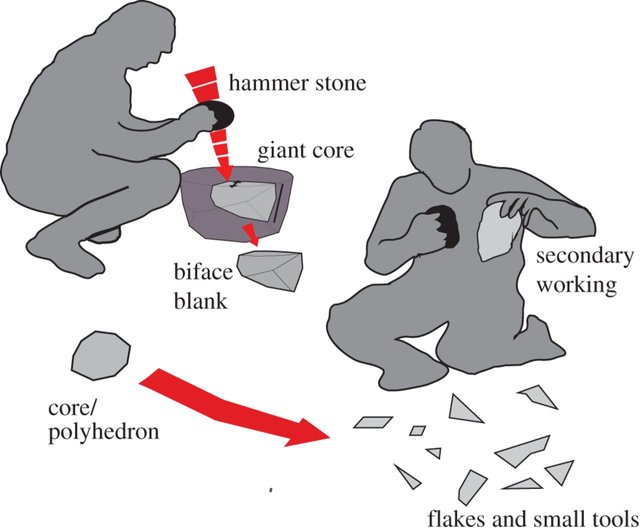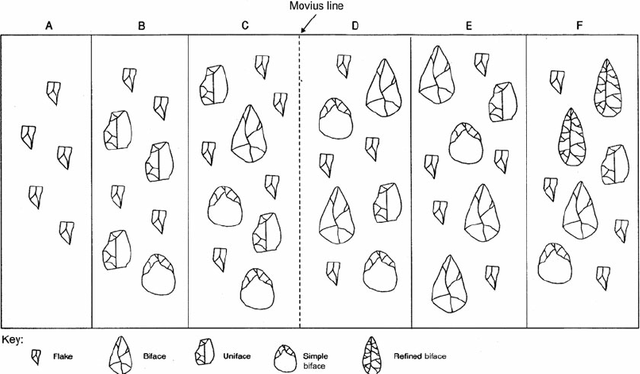The Early Stone Age : The Industrial Complexes
The Early Stone Age : The Industrial Complexes

Technology and Typology of Stone Tools
Throughout human history, human beings have used tools as a means to extend their limbs to alter and control their environment. Over the past three million years of cultural development, human technological achievements have been impressive. For most of human existence the primary raw materials used for human technology have been stone, bone and wood.

The manufacture of stone tools involves a "reductive technology". The stone worker obtains the raw material and prepares a core through the removal of primary flakes in order to obtain a specific shape.
~ A core refers to the piece of stone material from which flakes are removed.
~ A flake is a fragment of rock intentionally removed from a core. A flake can be used without being trimmed any further (although, if the artefact required is specialized, the stone worker can, in fact, do further trimming and shaping).
Note, also, that artefacts may later be resharpened or modified. A flake would need further retouching before being classified a tool. "Retouch" is when a flake is shaped or transformed into a tool by the further removal of small flakes.
A slightly more sophisticated flaking technique is required if a tool is to be used for a specific task.
~ A smooth pebble can be formed into the desired shape by systematically removing flakes when striking it with another stone, this is known as a core tool. The removed flakes are then primarily waste products, and the core becomes the "end product". Having said that, flakes struck from the core may also be used as shaped-edged knives or they may be further modified to make other artefacts. Indeed, many complex stone tools industries have developed from this simple beginning.
Industrial Complexes of the Early Stone Age

At present, an informal approach to the Stone Age is the norm, the archaeological artefcats are divided into sequential scheme of industries and complexes. The term Early Stone Age refers to the archaeological record from the first appearance of stone artefacts until the disappearance of large cutting tools such as handaxes and cleavers. The oldest stone artefacts currently found are from Gona in the Awash Valley of Etophia, Koobi Fora in Northern Kenya and Bouri in Ethiopia and are dated to at least 2.5 million years. This is followed by a wider variety of stone tool types during Middle Stone Age (MSA).
The two major complexes of (ESA) in Africa are the Oldowan and the Acheulian.
The Oldowan Industrial Complex
This term is used for the earliest stone tools made by hominins. The Oldwan Industrial Complex occurred in Africa during the Lower or Early Pleistocene, that is, from approximately 2.5 to 1.5 million years ago (mya). For many years scientific attention was focused on East Africa because the Olduvai Gorge site, in the East African Rift Valley in Northern Tanzania, offered unique opportunities for archaeological work owing to the remarkable preservation of Geological, palaeontogical records at this site. The associated stone tool industrial complex takes its name from the site Olduvai Gorge, Oldowan assemblages were first recognized at Olduvai Gorge by Louis and Mary Leakey. To date, this site has provided some of the most spectacular archaeological finds of early humans and their stone tools.
Having said this, little is known about the Oldowan complex. the stone implements that have bee found are fairly primitive. Typical tools are chunky cores showing scars where flakes were removed and quantities of irregular-shaped flakes removed from the cores. These cores sometimes have battered edges, suggesting that they were used for activities that required a pounding or chopping action. Previously, the use of cobbles as the principal raw material was regarded as diagnostic of Oldowan assemblages. However, this view has now been revised, since cobbles or pebbles are frequently used as primary sources of raw material for tool manufacture throughout all succeeding complexes. A cutting edge or point is obtained by the removal of a few flakes from the core. The most typical implement of this complex is the chopper: this tool is worked on either one both sides, the result being an irregular chopping edge. Polyhedral (polyhedral means "many-sided") stones and flakes with sharp cutting edges have also been found, and it is now generally accepted that the abundant flakes found at Oldowan sites could also have been used as working implements. The lumps of stone from which flakes have been removed are often put in the category of "tools", but many such stone pieces may have been cores rather than tools.

The Oldowan, in the truest sense, is known from only a few sites, widely separated in time and space. In view of the basic technology used, Oldowan assemblages are only positively identified at sites which fall within the time period during which these tools are known to have been in use. Oldowan sites occur in the lower beds of Olduvai gorge and sites along the easten Rift Valley, from Tanzania to Ethiopia; Oldowan sites also occur in Malawi. In South Africa artefacts from the Vaal River gravel deposits and elsewhere may be Oldowan. However, the only definite finds are from Sterkfontein and Swartkrans . Archaeologists agree that the Oldowan became more complex as it progressed. The transition or change from Oldowan to Acheulian is still being debated.
The Oldowan Industrial Complex in South Africa
Evidence of tool making is regarded as important in the emergence of humanity, and yet the use of stone and other tools by primates for obtaining simple food and other purposes is well documented. Relatively large Oldowan-type tools consisting of side and end choppers, bifaces, discoids, sub-spheriods, scrappers and picks were recovered from Sterkfontein and Swartkrans. Worn bone fragments, which were possibly used as digging tools, were also found at Swartkrans.
Materials used for the crude handaxes, choppers, flakes and irregular artefacts are mostly quartz with a few pieces in quartzite and diabase. A few unmodified pieces of haematite were found in association with the stone tools. Some of these handaxes could belong to a later phase, but the remaining artefacts could well belong to a phase of Oldowan.
It is difficult to date the complicated limestone cave sites. The dates are based on correlating the faunal remains with those of dated sites of East Africa, where potassium-argon dating and other cross checking dating techniques have given us reliable dates. The dating techniques based on regular evolutionary changes found in genera and species of some well-documented and representative groups of mammals is called faunal correlation or biostratigraphy and is an example of indirect or relative dating.
The levels at Swartkrans and Sterkfontein are dated earlier than Middle Pleistocene on the basis of associated fauna. The Oldowan artefacts from Member 5 at the Sterkfontein date between 2 million and 1.7 million years. The appearance of Homo species in South Africa falls within this period. According to Deacon and Deacon (1997:76) only an established population would leave enough archaeological traces behind for researches to be able to document such occurrences. This implies that the people making the Oldowan tools in South Africa were sufficiently numerous to make an impact on the landscape at an early stage in human history.
The Acheulian Industrial Complex
This complex derives its name from St Acheul in the Somme Valley in Northern France. This is the type-site where tools characteristic of this industrail complex were first discovered. The European site, however, represents a much later Acheulian than the Acheulian assemblages recovered from the early sites in Africa.
Acheulian assemblages have been discovered in Europe, Asia and Africa.
The Acheulian stone tool making tradition in Africa began approximately 1.5 mya and lasted until about 250 000 to 200 000 years ago. The handaxe or biface in its various forms was in use for about 1 million years and is the most characteristic tool type of this complex. Handaxes are usually pear-shaped and biconvex in cross-section.
They have a sharp edge around the periphery, usually showing bifacial flaking. Many handaxes were made from large flakes. The handaxes and other large cutting tools are collectively called bifaces, because they are usually shaped by flaking both sides. Bifaces are therefore classified as formal tools, because they have been shaped and transformed into specific shape and have been given a cutting edge through secondary retouching (ie by removing small flakes).

Handaxes have a very wide geographical spread and were manufactured in Africa for more than a million years until 250 000 years ago. The function of these tools is commonly described as all-purpose, but it is obvious that certain forms would be particularly suitable for certain tasks. They were possibly used for digging up veld roots, for wood working, as missiles or weapons, for butchering, marrow-processing and for a variety of other purposes. It is still not clear why the use of handaxes implied a major advancement and, once implemented, was used over such a vast area and for such a long period of time. One of the social and cultural implications of these early stone tools is the transference or learning of skills.
Initially, stone tools appear to have been manufactured for the butchering and preparation of animal foods, because hominin teeth were not strong enough to tear raw meat.
The bifaces associated with the Acheulian complex usually have very little damage on the cutting edge, which suggests that they were used in the preparation of soft materials for example in the dismembering of carcasses. The belief that these tools had a butchering function is also supported by the presence of large cutting tools such as handaxes found in association with animal bones at sites where faunal remains have been preserved.

Microwear studies (the specialized microscopic study of the physical marks of artefact utilization) have also shown that these early stone tools were used for cutting meat,wood and plant stems, which suggests that stone tools were also probably for making other tools, although this is as yet impossible to prove. An example of this is the use-wear analysis on two chert handaxes from Wonderwerk Cave predating 350 000 BP, the analysis indicates that these handaxes were used to process vegetal remains. Even the simplest tool kits comprise versatile stone artefacts which could be used for a variety of purposes.
There is a degree of standardization common to the Acheulian industries that is lacking in the Oldowan industries. This implies that activities in the Acheulian industries were specialized. It is now evident that there was no gradual technological improvement, over a period of time, in the manufacture of Acheulian artefacts (as was previously thought).
In addition to handaxes, Acheulian assemblages usually also contain cleavers made on a large flake or pebble. These efficient tools could have been used for butchering, wood working, chopping, cutting and various other purposes. Although cleavers are widely found in Africa, they are virtually absent from rich sites in Europe such as Swanscombe. A variety of flake tools and different scrapers, as well as polyhedral (polyhedral means "many sided") stones, gravers, choppers and picks are found in Acheulian assemblages.
The Acheulian Industrial Complex in South Africa
Our knowledge of Aucheulian in South Africa is limited, mainly because only a small number of undisturbed archaeological sites are associated with this complex. Only a few sealed Acheulian sites have been excavated. Surface sites of stone artefacts are more common. Assemblages originating from open sites are difficult to date because such sites have little associated material to aid the dating and these sites have often been disturbed by natural or human activities (which obviously also makes dating more difficult).

The many Acheulian sites in southern Africa located near rivers in valley bottoms or wetlands indicate a preference for a particular habitat (which could provide relatively constant sources of water and also animal and plant foods). Most of the Acheulian sites are therefore open-air localities such as the Klipplaatdrif and Three Rivers sites of the Klip River terraces (Gauteng). Numerous Acheulian sites also occur in the Vaal-Orange basin, including Doornlaagte, Canteen Kopje, Pniel, Power's Site, rooidam and Kathu Pan. Some of the sites in the Vaal River basin, which contain vast quantities of artefacts (eg: The Power's Site and Doornlaagte), my have been repeatedly occupied. The startigraphy of many of these sites is problematic because of the water and mining activities. Consequently, the dating of these sites is uncertain. Other rich Acheulian sites are Elandsfontein near Langebaan on the south-west Cape coast, Amanzi near Uitenhage and Florisbad (Free State).
Only a few cave sites with Acheulian assemblages are known, namely the Cave of Hearths and the Wonderwerk Cave, and possibly Olieboomspoort Shelter, Montagu Cave and Peers Cave. Some caves sites from middle Pliestocene have eroded away, which might mean that these caves were more frequently occupied than present evidence suggests.
Thank you for reading
References: Deacon & Deacon
Please Follow me for more on Archaeology and History.
Please check out my other posts:
The Early Stone Age : Physical types associated with it.
Methods of absolute (direct and chronometric) age determination : Part 3
Dendrochronology or tree-ring dating and Obsidian hydration Methods of absolute (direct and chronometric) age determination : Part 2 Potassium-argon dating and other Radioactive dating Methods
Methods of absolute (direct and chronometric) age determination : Part 1 - Radiocarbon or 14C Method
Methods of Relative (Indirect) Age Determination used in Archaeology : Part 3
Methods of Relative (Indirect) Age Determination used in Archaeology : Part 2
Methods of Relative (Indirect) Age Determination used in Archaeology : Part 1 - Introduction
The Preservation of an Archaeological Site : Part 2
The Preservation of an Archaeological Site : Part 1
Discovering your own Archaeological Site : Part 3
Discovering your own Archaeological Site : Part 2
Discovering your own Archaeological Site : Part 1
Archaeological Sealed Sites and River Deposits : Is it an Archaeological Site or Not? - Part 3
Caves, Rock Shelters and Larger Open-Air Sites : Is it an Archaeological Site or Not? - Part 2
Is it an Archaeological Site or Not? - Part 1
Understanding the Archaeological Record : The Aims and Subject Matter of Archaeology - Part 2
The Aims and Subject Matter of Archaeology - Part 1
Archaeology and the Natural Sciences
Introduction to Ethnographic Analogy and Ethnoarchaeology
The Nature and Scope of Archaeology
The Three - Age System : The Stone Age, The Bronze Age and The Iron Age
The Roots of Modern Archaeology
Significant 18th and 19th Centuries Discoveries in Archaeology
Archaeology as a Profession- Part 2
Archaeology as a Profession- Part 1
To Become or Not Become an Archaeologist? - Introduction to Archaeology Part 2
Please Upvote and Resteem.
Thank You!
Upvoted on behalf of the dropAhead Curation Team!
Your post will be Resteemed by @dropahead witness account of the dropAhead curation team!
Watch out for the #xx-votesplus tag!
By doing the above you will give us more STEEM POWER (SP) to give YOU more earnings next time.
Keep up the good work!
My brother-in-law and I found a beautiful stone handaxe in the "Red Desert" area near Port Edward. We left it in situ. Further down the coast south of the Wildcoast casino is an area rich in fossils.
Well done @petruska13, did you report the find? I am aware of the fossils located at the Wild Coast casino, on the beach there is a cave which was used as a shelter, there also fossils embedded into the shoreline. DM on Steemit chat, would enjoy chatting to you :)
This happened about 20 years ago, If I recall correctly my brother-in-law who lives in the area did report it. I will look in on the chat room soon. I remember that there were some fossilised trees trunks lying at the waters edge, unfortunately people had been chipping of pieces as souvenirs. I doubt whether this has stopped.
In the beginning of my study of archaeology I was a member of an educational excavation in Germany. On the first day I found a green stone in a special shape which caused our teacher to take a lot of phone calls and made us all sooo excited. I spent the whole night doing research about ax-heads made of jade in the early neolithic times... but at the end... it was just a nice, green stone. :D But will never forget this feeling when you peel something out of the soil, not knowing if it is just rubbish or a treasure. ;)
Hi @laylasophia, Thank you for the awesome comment, I totally agree, that thrill of finding your very first archaeological artefact is a complete rush, but as you have experienced personally sometimes it can be nothing. I hope you still actively involved in Archaeology, come join us at SteemSTEM chatroom on Steemit Chat. Thank you for the great comment and support!
Thank you @zest for the invitation to chat.
Yes I am still active as an Egyptologist, living in Germany and Egypt. My husband is restorer and we are both still amazed by even the smallest finding, even if it is just a small piece of decorated pottery. When you know that piece is more than 5000 years old and waited so long to be found by YOU - this is the rewarding moment by itself. ;)
This post has received a 3.91 % upvote from @buildawhale thanks to: @trumpman. Send 0.100 or more SBD to @buildawhale with a post link in the memo field to bid on the next vote.
To support our curation initiative, please vote on my owner, @themarkymark, as a Steem Witness
Congratulations @zest! You have completed some achievement on Steemit and have been rewarded with new badge(s) :
Click on any badge to view your own Board of Honor on SteemitBoard.
For more information about SteemitBoard, click here
If you no longer want to receive notifications, reply to this comment with the word
STOP